Content
- 1 Is it possible to grow an apricot from a stone at home
- 2 How to germinate an apricot pit
- 3 How to plant a pitted apricot
- 4 Will an apricot grown from a stone bear fruit?
- 5 Do I need to graft apricot grown from a stone
- 6 Where to get a bone
- 7 When to plant
- 8 Autumn planting rules
- 9 Seed stratification
- 10 Landing in the ground
- 11 How to grow an apricot from a stone: choosing a permanent site
- 12 Homemade apricots
- 13 How to grow apricot from stone at home
- 14 Helpful advice
- 15 Does it make sense to grow an apricot from a stone?
- 16 Apricot - from preparing seeds to planting in the ground
- 17 Growing and caring for an apricot in the first year
Growing an apricot from a stone is an interesting and exciting process. A young tree can be planted in open ground, or you can leave it at home.
Is it possible to grow an apricot from a stone at home
Apricot grown from seed is more adapted to the local climate than seedlings brought from other regions. However, the process of seed germination is long, in order to speed it up, you need to plant it correctly. Usually apricot is planted right in the ground before winter, but if mice live on the site, they can eat all the bones, so it is better to grow seedlings at home.

To prevent mice from eating apricot seeds planted in open ground, they can be grown at home.
How to germinate an apricot pit
Inside each fruit is a hard drupe with a nucleus. In order for the seed to germinate, stratification is necessary - prolonged exposure to certain temperatures. Fresh seeds show the best germination. Cooked apricot pits from compote will never sprout.
If the tree in the future is planned to be planted in open ground, then the choice of planting material must be taken responsibly. For planting, choose seeds from sweet apricots, taste not only the pulp, but also the nucleolus.
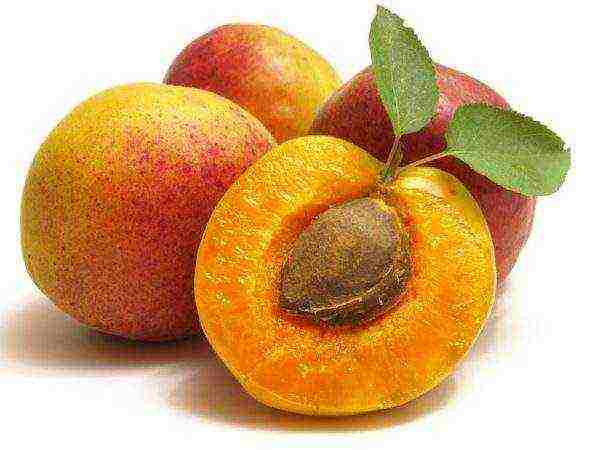
Before planting, taste not only the pulp, but also the apricot kernel, which should not be bitter
Sweet apricots also have a sweet kernel - the fruits of a tree grown from such a seed are likely to be tasty too.
Soak the bones in water and remove the floating ones. Dry bones need to be soaked for about three days, be sure to change the water every day. In this case, it is advisable to use rain, melt or spring water.
Do I need to germinate a seed before planting
To get guaranteed shoots of apricot, it is advisable to germinate the seed before the root appears. To do this, stratification is carried out in a cool place - a refrigerator or cellar:
- The soaked bones are sprinkled with washed river sand, vermiculite or sawdust. Then moisten and place in a container or bag.
- The container is left in a cool place, for example, in a refrigerator, and kept there at a temperature of +2 ° C.
- Usually after 90-100 days roots begin to hatch.
Be sure to check the seeds during the stratification period so that they do not dry out or become moldy due to excess moisture.
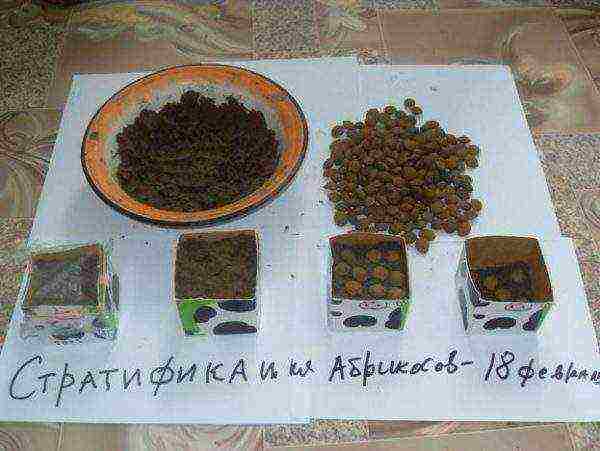
For the best germination of apricot seeds, it is necessary to stratify them before planting.
If it is necessary to speed up stratification, the container is periodically placed in the freezer for several hours, then transferred to a shelf for storing fruits, where the temperature is + 6 ... + 10 ° С. So the bones are kept until planting in the ground or pots.
It is much easier to observe bones placed in damp cloths and a plastic container.
Video: stratification of seeds in tissue and planting them
How to plant a pitted apricot
In their natural environment - in the open ground - apricot seeds hatch only with the arrival of spring after the snow has melted. If stratified in the refrigerator, then pecking occurs in about three months.
Choosing a pot for planting
When growing apricot seedlings at home, it is better to take individual containers for each seed. Since the root system of the apricot is pivotal, the pot should be deep: it is better to take a half-liter disposable glass or a cut one and a half liter bottle.
In the bottom of each glass, it is imperative to make holes to drain excess water.

A tall plastic cup is perfect as a container for planting apricots
Soil for apricot
Apricot is not very picky about the acidity of the soil, so the soil can be bought universal or for seedlings, based on peat. However, such soils are often not of good quality, so it is better to prepare the soil mixture yourself.
For 10 liters of garden soil or purchased soil, 1 liter of biohumus is taken and 1 glass of vermiculite is added. These components will give nutrition and looseness to the prepared soil mixture. To retain moisture, it is advisable to add soaked coconut substrate; for this, the briquette is poured with 1-2 liters of water and, after swelling, mixed with soil.
Photo gallery: components for high-quality soil mixture
Planting process
The growth and development of the seedling will depend on the correct planting of the apricot kernel.
Planting stages:
- At the bottom of the selected pots we pour drainage - small expanded clay.
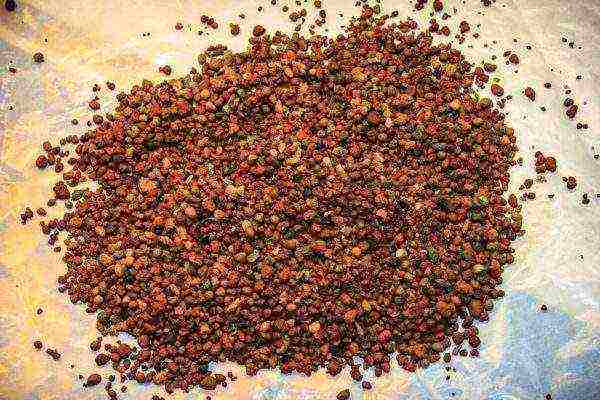
Fine expanded clay must be placed on the bottom of the apricot container
- We put the prepared soil mixture into the pot, without adding 1–2 cm to the edge of the pot, and slightly compact it.
- We lay out the sprouted apricot seeds on the surface of the soil, 1 seed per pot, with the root down. Do not deepen the bone, as this can subsequently lead to decay of the root collar. You can sprinkle earth only on the spine itself.
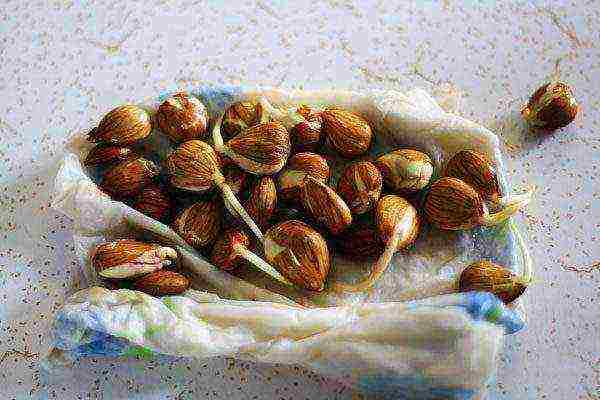
It is better not to burrow sprouted apricot seeds into the ground, so as not to provoke further decay of the root collar
- Lightly water the bone and cover with a film so that the moisture does not erode, and we place the pot itself in a warm place.
- We periodically inspect the plantings: ventilate and remove condensate from the film.
- As soon as sprouts appear, we rearrange the pots on a light warm windowsill, you can also put them under phytolamps if there is no sunny window.
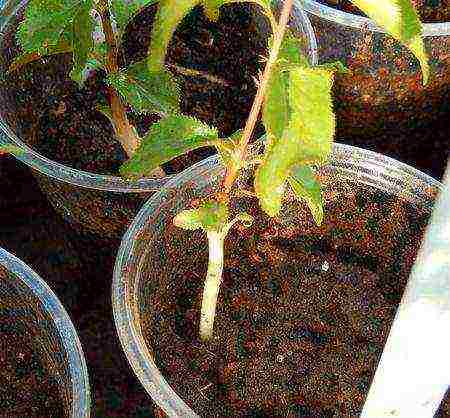
The emerging apricot sprout is immediately exposed on a light windowsill or under a phytolamp
The best temperature for the growth of apricot is + 24 ... + 26 ° С. Watering is carried out as the soil dries up.
Will an apricot grown from a stone bear fruit?
If you plant an apricot in open ground in the spring after return frosts, then there is a great chance that the seedling will take root and will bear fruit in a few years. But do not forget that apricot is a southern plant and in cold climatic conditions it often dies from frost.
When choosing a place for planting apricots in open ground, preference should be given to sunny places, without drafts and stagnant cold air. When groundwater is near, it is recommended to land on a hill. Apricot grows best on loamy soils.
Planting a seedling in the ground
It is worth planting an apricot seedling in the ground in the first spring, almost immediately after the emergence of shoots. Before the onset of autumn, the tree should get stronger, develop a good root system and prepare for winter. If this is not possible, then the apricot is first planted in a large container, and only then in the ground.
For such a compact plant, you do not need to make standard deep planting holes. Better to put a few buckets of compost in the soil and dig it up well. When transplanting a seedling into the ground, the plant should not be buried; the ground level should be the same as in the pot.
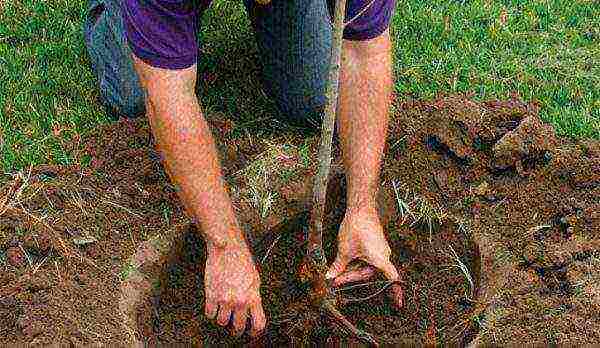
When transplanting an apricot into the ground, the plant must not be buried, the root collar must be open
The less you repot the plant from place to place and damage the root, the sooner you can see the fruit. The growth force of an apricot is enormous - in one summer, with proper care, it can grow by 1 meter.
Usually apricot from stone blooms in the 4th or 6th year.
Growing apricots in an apartment
If you wish, you can leave the apricot in the apartment and grow it as a houseplant. The place for the tree is chosen warm, with the morning rays of the sun, so the best option would be an east or south window.
You cannot feed the apricot with fresh organic matter in the first year, because it will constantly grow and will not be able to form good buds by winter.
Wintering should take place in a cool room, it is better if it is a winter garden or a cold cellar, where the temperature is kept within 0 ... + 2 ° С. It is necessary to place the apricot for the winter after the natural leaf fall has passed and the tree has dropped its leaves.
In winter, you also need to monitor the moisture content of the earthen coma in a pot or tub so that the roots do not dry out. In spring, apricot is brought into a warm place at the time of swelling of the buds or positive temperatures outside.
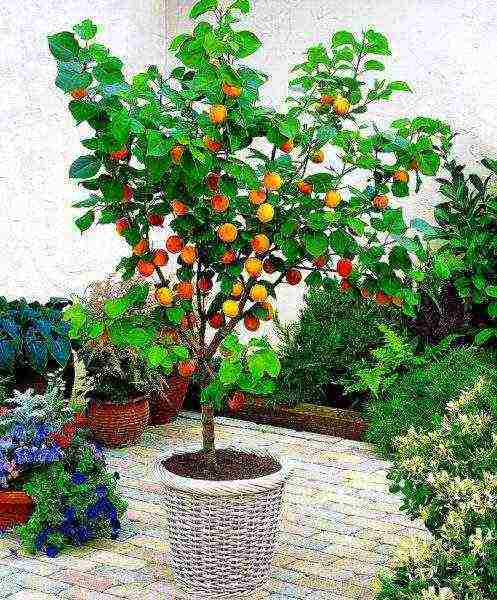
To grow apricots at home, you need to pick up a pots with a volume of 30 liters.
Since it is impossible to provide a bulky container to an apricot in room conditions, a large tree will not grow - a maximum of 1.5-2 meters. The pot is increased gradually, replanting the plant every year at a young age and every 3-5 years in an adult. For good growth and flowering, a tub of at least 30 liters in volume is recommended.
Do I need to graft apricot grown from a stone
Apricots grown from seeds are not always as tasty as those of the mother plant, so another variety can be grafted onto such a tree. In addition, if several varieties are inoculated into the crown, then the total yield of the plant will also increase due to cross-pollination.
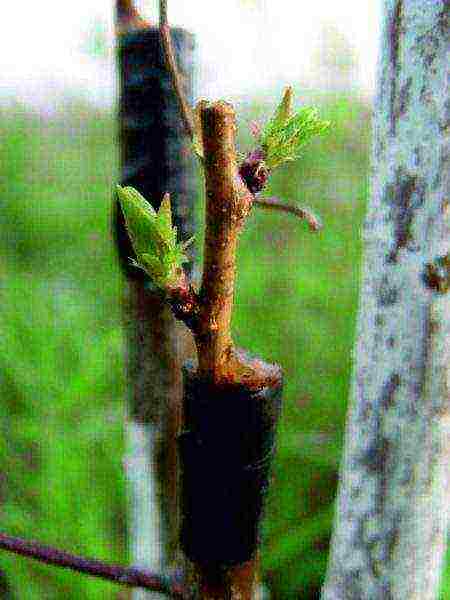
If several varieties are inoculated into the crown of an apricot, then the total yield will increase.
It is possible to grow an apricot from a stone, but it will not begin to bear fruit very soon. For planting, choose local apricots that suit your taste and size - this will be more likely that trees grown from seedlings will take root well in your area.
Hello, my name is Irina, I am 33 years old. I love my collection of hippeastrum very much, but I do not offend other flowers either. Rate the article:
(4 votes, average: 4.5 out of 5)
Apricots are grown, of course, mainly in the south. Recently, however, a large number of varieties have been bred that take root well and bear fruit well, including in the rather harsh conditions of central Russia and even Siberia.
Of course, many summer residents would like to plant an apricot on their site. Meanwhile, the seedlings of these fruit trees are quite expensive. Therefore, many gardeners have a question about how to grow an apricot from a stone. This is a simple matter, but it requires strict adherence to a certain technology. If desired, you can also grow this fruit tree in a city apartment.
Where to get a bone
Apricot is one of the few crops that almost completely retains parental qualities when planted in this way. Often, even trees grow from the seeds, giving much larger and more tasty fruits than the mother's. But, of course, the question of how to grow an apricot from a stone comes down to, among other things, how to choose the right planting material. It is desirable to collect it from winter-hardy zoned apricots. Best of all from those that are successfully grown by gardeners in the same area where your summer cottage is located. Of course, the fruits of zoned apricots are usually much smaller than the southern varieties. However, in terms of taste, they are practically not inferior to the latter.
The seeds are taken from the largest and sweetest overripe fruits. Harvested apricots, depending on the variety, in June - August. The selected material is dried, placed in a glass jar and stored in a refrigerator.
When to plant
The question of how to grow an apricot from a stone comes down, among other things, to the choice of the correct planting dates. This procedure can be performed both in spring and autumn. In the first case, gardeners usually manage to get almost one hundred percent yield of young plants from seeds. When planted in autumn, the strongest plants survive. Subsequently, they can be used, among other things, as a frost-resistant rootstock for more delicate varieties of apricots.
Autumn planting rules
So let's see how to grow an apricot from a seed. Autumn planting is done as late as possible. The fact is that apricot seeds are a real delicacy for all kinds of rodents. It is best to plant in November, before the real frosts hit. The bones are taken out of the refrigerator and immersed in water for a couple of days. In the fall, it is better to plant the seeds deeper (by 4-6 cm). Otherwise, the sprouts may freeze.
Previously, a long groove is dug into the ground with a depth of about 10-15 cm. Then a little humus mixed with the ground is poured into it. Further, at a distance of 10 cm from each other, the bones themselves are laid. It is desirable to place them with the sharp end up. Sprinkle the bones with a mixture of humus and finely chopped grass.
Seed stratification
Those summer residents who wondered how to grow an apricot from a stone should know the rules for sanding this planting material. The fact is that if the seeds collected in the summer are simply planted in April-May, most of them will not sprout. One hundred percent germination can be obtained only if the seeds are first subjected to a stratification procedure. Its duration for apricots, depending on the variety, is 80-100 days. Spring planting of apricots is usually done at the end of April. Therefore, seeds for stratification should be planted in late January - early February.
This procedure is carried out as follows:
- the bones are removed from the jar,
- holes are cut in the plastic bag,
- a little sifted moistened sand is poured on their bottom,
- part of the bones is laid out on top,
- sand is poured again,
- another row of bones is laid,
- sand is poured.
Next, the package should be wrapped on top and placed in the refrigerator under the freezer itself. The stratification of apricot kernels should take place at a temperature of about 0-5 grams. The sand and seed bag should be shaken weekly to avoid excessive compaction.
Landing in the ground
Now let's see how to grow an apricot from a stone in the country in the spring. In April, the seeds should be buried in the ground by about 2 cm. The small root collar of the sprouts should not be covered with soil. Otherwise, the plants may vanish. Previously, the soil in the selected area is fertilized with a mixture of humus (30 kg), ash (2 kg), superphosphate (0.5 kg) and potassium sulfate (250 g). Just like in autumn, a groove is preliminarily made in the ground. Further, bones are placed in it with a sharp end up at a distance of 10 cm from each other and sprinkled with soil.
After planting, the site is mulched with sawdust and spilled. Subsequently, it is moistened several more times per season at intervals of about two weeks. It is impossible to allow the soil under the apricots to dry out. It is not worth pouring over young sprouts.
How to grow an apricot from a stone: choosing a permanent site
The place for young plants should be sunny and elevated. Apricots do not like the close occurrence of groundwater.
The transfer of seedlings is carried out in the second year after planting the seeds in the ground. A hole is dug under them with a depth and width of about 70 cm. The distance between the trees should be about five meters.The dug hole should be covered with a mixture of garden soil, humus and ash in half. Next, a seedling is installed in it. After its roots are straightened, the pit is covered with soil. At the final stage, the seedling is watered and mulched.
Moisten the ground under newly planted trees at intervals of about three weeks until the end of August. The next year, the apricots are watered twice in the spring and twice in the summer. This technology is an excellent answer to the question of how to grow an apricot from a stone in the country, healthy and productive.
Homemade apricots
Of course, most often this fruit tree is planted in the garden. However, some indoor plant lovers are also interested in the question of how to grow an apricot from a stone at home. Unfortunately, in the conditions of a city apartment, it is almost impossible to obtain a varietal tree. In a pot, a so-called indoor game will grow from a bone, absolutely sterile. Home apricots bloom quite rarely. However, their leaves are very beautiful, and the trees themselves grow neat and attractive.
How to grow apricot from stone at home
In this case, no preparation of the planting material is necessary. The seeds are planted freshly in the pot. The prepared container is usually filled with nutritious garden soil. If it is sour, you can add a little ash or dolomite flour to it. Apricots love neutral soil.
Of course, the question of how to grow an apricot from a stone at home comes down to, among other things, how to choose the right pot for it. The container for a young plant can be taken not too large. Apricots tolerate transplanting very well. Therefore, in the future, the grown plant can be easily "transferred" into a pot that is more suitable in size. The bone is buried two centimeters. It will take a long time to germinate - within about two months. All this time, the soil in the pot must be watered and loosened periodically. Apricot grows in room conditions not too high - about a meter and a half.
Helpful advice
So, you now know how to grow an apricot from a stone at home. Of course, ordinary garden nutrient soil is also suitable for this plant. However, before planting, many indoor plant lovers add some kind of potash fertilizer to it. Apricots love this trace element very much and respond to it with rapid growth. Feeding adult plants indoors is done twice a year. In this case, you can use both organic and mineral complex fertilizers.
Thus, we have figured out how to grow an apricot from a stone in a pot and in the country. This matter, as you see, is quite simple. The main thing is to follow exactly the planting technology and water the plant on time. In this case, it will thank the summer resident with a rich harvest, and the lover of indoor plants with its chic semi-exotic appearance.

How to grow an apricot from a stone, if in Russian conditions even varietal seedlings do not always turn into fruit-bearing apricot trees? Is there enough heat for a small bone to sprout, and how to help a delicate plant adapt to an unusual climate? Following our recommendations, you will see from your own experience that this task is not as difficult as it seems.
Does it make sense to grow an apricot from a stone?
Now you can easily buy quality apricot seedlings on the market or order online. The varieties are offered zoned, adapted to the Russian climate, and the variety of varieties makes it possible to choose apricots with the best characteristics. Why create difficulties for yourself, trying to get a big tree from a small bone?
The reasons may be different: someone is confused by the high cost of seedlings (after all, for effective pollination, it is advisable to plant 2-3 apricot trees), others cannot achieve good fruiting from varietal seedlings, others like to experiment by creating new varieties of apricots.
Video about planting an apricot from a stone
In one opinion, gardeners who practice the cultivation of apricot from the stone converge: the trees are more unpretentious, adapted to the local climate and soil characteristics. The main care for apricots is reduced to watering and fertilizing, while pests are practically not necessary to fight. In addition, you can plant as many seeds as you like, subsequently selecting the strongest plants - a great opportunity to create a gorgeous apricot garden!
Parental qualities when planting apricot pits are rarely inherited, but unlike those grown from apple seeds, there is much less risk of getting wild. From stone fruits, seedlings are often obtained that surpass their parents in taste and in fruit size.
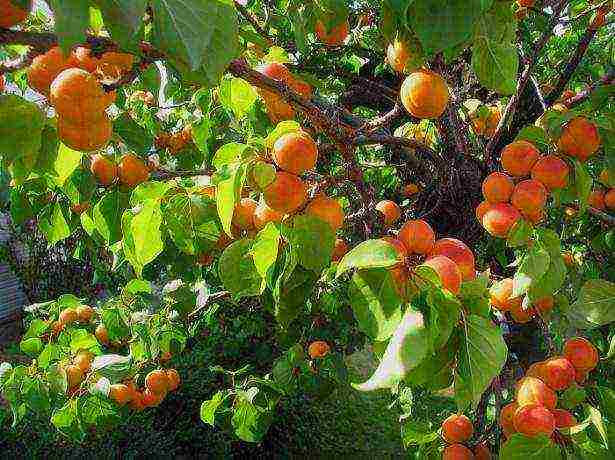
The main care for apricots is reduced to watering and fertilizing
Apricot - from preparing seeds to planting in the ground
For planting, it is best to take seeds from apricots that grow in your area. If you can't get local fruits, you can order planting material from gardeners who live in the Far East or Siberia. Apricots growing in such harsh climatic conditions are highly viable, therefore, their descendants will take root well in any corner of Russia. As a last resort, you can use apricot pits bought on the market. Just do not take large fruits of imported varieties - it will be difficult to grow them.
Use the best apricots for reproduction, slightly overripe, with easily separated flesh. Rinse the resulting bones and dry in the shade.
It is not recommended to plant seeds in pots, because they need natural hardening. A seedling carefully grown at home will simply die at the first frost, it is worth transplanting it to the street. However, do not expect that all crops will sprout on the apricot garden bed: after a harsh winter, only the strongest sprouts will survive. And if you plant the bones in the ground in early autumn, then rodents will immediately take away a good part. Therefore, planting should be done in mid-autumn, before the ground freezes, or in mid-spring.
Before the autumn planting, it is enough to place apricot pits in water for a day in order to immediately reject those that have surfaced. The remaining bones are planted in trenches to a depth of 6 cm, every ten centimeters. For best results, you can make the trenches a little deeper and lay out the bottom with a mixture of grass, sand, earth and humus. It is also advisable to sprinkle it with humus and grass on top of the garden. During the winter, the apricot pits will undergo natural hardening, and in the spring, tender sprouts will appear.
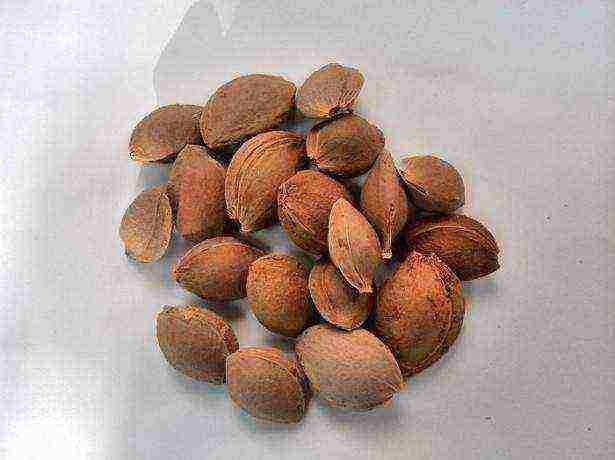
Planting seeds in pots is not recommended, because they need natural hardening
If planting is postponed to spring, the apricot pits will need to be stratified (as when growing pitted cherries). You can put the seeds in a box of sand and put them in the refrigerator for the whole winter, or take dry seeds in mid-March and put them in water for three days, remembering to change it every day. After soaking, the planting material is placed in wet sand and moved to the basement, and in April it is sown in open ground, as soon as the weather permits.
Growing and caring for an apricot in the first year
Green shoots that appear in spring can be killed by crows, magpies, hares and small rodents. For protection, experienced gardeners cover delicate plants with transparent plastic bottles with cut bottoms. Such a simple solution does not require financial costs and unnecessary efforts, allowing apricot seedlings to grow and gain strength in peace.
Over the summer, with regular watering and careful loosening of the soil, apricots have time to grow well. Therefore, in September, they can be transplanted to a permanent place - it is better if it is sunny, although in the shade the trees will also bring decent harvests.
Video about growing and caring for apricots
Tips for growing apricots from seeds:
- Pits for transplanting seedlings should be prepared in advance, filling the bottom with a mixture of humus, ash, leaves, tops and grass. On top of organic fertilizers, soil is poured and the roots of the seedlings are spread over it, completely filling the planting hole with earth.
- From the first year in March, pruning of apricot seedlings is carried out, removing weak and frozen branches and shortening too long shoots.
- In summer, the seedlings are watered abundantly once every two weeks, sprinkling sawdust on the near-stem circle to protect it from drying out.
- Since apricot trees grown from stone lack a central trunk, special attention should be paid to the formation of the crown of the seedlings.
- From the fifth year, the trees begin to bear fruit abundantly, at this time it is recommended to put props under the branches so that they do not break under the weight of the fruit.
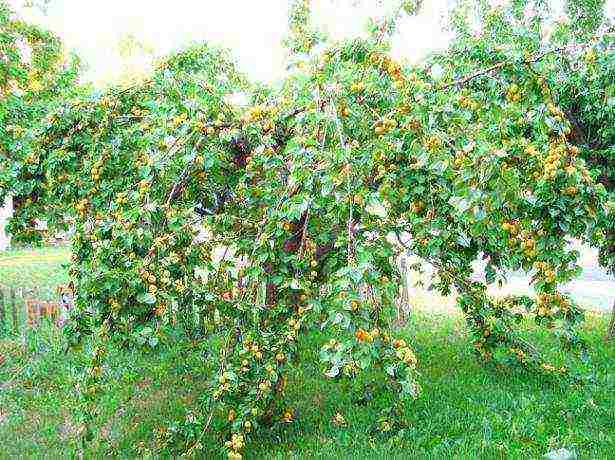
From the fifth year, the trees begin to bear fruit abundantly.
It is actually easier to care for apricot trees that were grown from ordinary seeds, because they are characterized by increased unpretentiousness and can bear fruit remarkably even on infertile land. According to experienced gardeners, such apricot trees delight with annual rich harvests and excellent fruit taste.
Rate the article:
(40 votes, average: 4.6 out of 5)
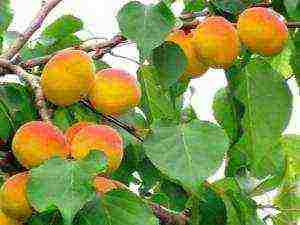
Everyone likes the aromatic and juicy fruits of apricots. They are delicious and healthy. Many gardeners in various regions dream of growing this crop on their site.
There are two ways to make this dream come true:
- buy ready-made seedlings in the market or in a specialized store;
- try to grow them yourself from the seeds.
The second one is more suitable for those who like to experiment, since caring for young seedlings will require a lot of patience, attention and work.
Peculiarities
In order for the seedlings to grow well and please for a long time with a rich harvest, it is important to consider some conditions.
- Choose apricots for cultivation, taking into account the climatic conditions of the region. When choosing, you need to adhere to some simple rules.
- It is advisable to take seeds from local fruits, the most ripe (even overripe), soft and sweet. If southern varieties are sown in cold climates, they either will not grow at all, or in the first winter they will die from frost.
- You can order planting material from amateur gardeners from South Siberia, Khakassia or Orenburg - these plants will grow and bear fruit in almost any area, as they have passed natural selection and good hardening in a harsh climate.
- Remember that the germination rate of apricot kernels is very low, about twenty to thirty percent, therefore, they need to be sown, as they say, "with a margin."
- Seedlings do not always inherit the taste of the mother plant - a wild can grow from a pit from a sweet apricot, perhaps, on the contrary, the fruits will be of higher quality. In this way, you can bring out a new, own apricot variety.
- Young trees will give their first fruits only after six to seven years. Only then will the results of the experiment be known.
How to plant?
It is quite possible to grow an adult fruiting apricot from a stone at home. The step-by-step instructions include several steps.
Before planting, the seeds must be peeled from the pulp and rinsed. Then soak for two - three days in rain, snow or spring water, changing it daily.
The emerging ones can be immediately thrown out without regret - these are "dummies", nothing will grow out of them. There is another popular way to determine ripeness: to taste the kernel. Sweet ones can be planted, bitter ones are thrown away - nothing good will come of them.
Planting times may vary.
- "From the mouth to the ground" - Immediately plant the bone from the eaten fruit in the ground.
- Late autumnas soon as the soil freezes slightly from above. At the same time, future seedlings undergo natural selection, in the spring only the strongest and hardiest will emerge.
- If it was not possible to plant the seeds in the fall, this can be done and in the spring.
In the latter case, forced stratification (germination) is carried out. To do this, the soaked bones are covered with clean river sand, vermiculite or sawdust, moistened and refrigerated at a temperature of +2 degrees for three to four months before the onset of heat. It is necessary to ensure that the filler is constantly wet, but at the same time do not allow stagnation of water and the appearance of mold.
You can simply wrap the seeds in a damp cloth and place them in a plastic bag or container with a lid. Sometimes, in order to speed up the stratification process, the crops are arranged with temperature drops. To do this, the container is placed first in the freezer for several hours, and then on the lower shelf of the refrigerator, where the temperature is about +8 degrees.
After the emergence of sprouts, it is better not to pull with the planting, since the delicate roots are easily damaged.
You need to prepare a place in advance: dig a trench (deep on a shovel's bayonet), fill it with humus or well-rotted compost. Bones are planted to a depth of three to five centimeters, keeping a distance of at least ten centimeters between them.
If you plan to grow a seedling immediately in a permanent place, without transplanting, prepare a planting pit as for an ordinary seedling. Fill it with humus or compost, add a handful of wood ash. A bone is also placed in the center of the pit to a depth of three to five centimeters. With this method of planting, a young tree usually begins bearing fruit two to three years earlier, since the root system is not injured during digging. The main taproot extends far into the depths, which further provides a better supply of moisture and nutrients, and also gives the tree additional resistance to strong winds.
If necessary, you can plant the bones at home, in a pot with nutritious soil.
- It is better to take a separate container for each plant. Disposable plastic cups with a volume of half a liter or plastic bottles are suitable.
- Holes are necessarily pierced in the bottom to drain excess water.
- The soil can be taken with a store-bought (universal mixture) or prepared independently by mixing garden soil, humus (or vermicompost), adding a little fine vermiculite. To better retain moisture, a coconut substrate is added (it is pre-soaked until it swells).
- At the bottom of the glass, a layer of expanded clay of fine fraction is placed for drainage.
- Prepared soil is poured on top, not reaching one or two centimeters to the top.
- In the center of the pot, germinated seeds are placed on the surface of the soil, one piece in each. You do not need to bury them in the ground. Lightly sprinkle only the spine.
- The crops are watered with a small amount of warm water and covered with foil, the pot is placed in a warm place.
- Landings periodically need to be inspected, ventilated and condensate that appears from the film.
- When shoots appear, the shelter is removed and the plants are placed on a sunny window. The optimum temperature for the growth of apricot is + 24 ... 26 degrees.
- Water sparingly when the soil dries slightly.
- Such seedlings need to be hardened before planting - put in a cool, well-lit place.
The apricot can grow and bear fruit in the room.
Transplant to open ground
It is better to replant seedlings immediately in the first spring. A young tree will have time to take root, get stronger and prepare for winter over the summer.
Apricot is a thermophilic plant, so it is better to choose a sunny place for it, closed from northern winds and drafts.
- Planting pits are prepared in advance, in the fall.
- If the groundwater in the country is close to the soil surface, the seedlings are placed on embankments to avoid podoprevanie. For the same reason, it is impossible to deepen the root collar of the seedling.
- Apricot is loyal to the composition of the soil, but it will grow and bear fruit best of all on loam.
Apricot usually grown from a stone will bloom for the first time in the fourth - sixth year.
Care
Young shoots and newly planted seedlings can damage birds or animals. To avoid this, each seedling can be covered with a cropped plastic bottle on top. This simple protection will allow the plants to grow and gain strength.
Apricots grown from seeds are unpretentious and do not require special care. They are well adapted to the soil composition and climate of the area where they were sown.
Therefore, timely weeding, loosening and watering, if necessary, will be quite enough for them. In regions with harsh climates, it is better to cover young plants for the winter to protect them from frost and rodents.
The next year, in the spring, they begin to prune and form the crown of the future tree:
- remove frozen and weak, undeveloped twigs;
- too long shoots are shortened;
- the tips of the branches are pinched for better branching.
In the future, as it grows, the crown continues to form, removing the inward and intersecting branches.
Weed, water and loosen the soil around the seedlings. It should be remembered that the root system of the transplanted apricot is superficial. Therefore, after each watering, the trunks should be mulched with sawdust or other suitable materials. You can equip a garden bed and plant flowers or vegetables.
If the taste of the fruit is mediocre, the apricot can be grafted with cuttings from other trees. Grafting several different varieties into the crown significantly increases the quantity and quality of the crop. This is due to cross-pollination.
Caring for mature trees includes timely watering, weeding, sanitary and formative pruning and feeding.
After the onset of fruiting, it is important to ensure that the branches do not break off under the weight of the fruit, substitute supports under them.
Growing tips
Every gardener can grow an apricot from a stone on his site.
It is important to remember the following points:
- choose the right planting material;
- check germination;
- carry out stratification;
- sow at the right time;
- carefully look after seedlings, protect them from damage by birds, rodents and frost;
- timely form the crown of the tree, carry out sanitary pruning;
- in the fall after harvesting, feed with potassium-phosphorus fertilizers.
If you follow the planting technology and follow all the care measures, then after four to six years you can enjoy the fragrant and sweet fruits from your own garden.
For information on how to grow an apricot from a stone, see the video below.


